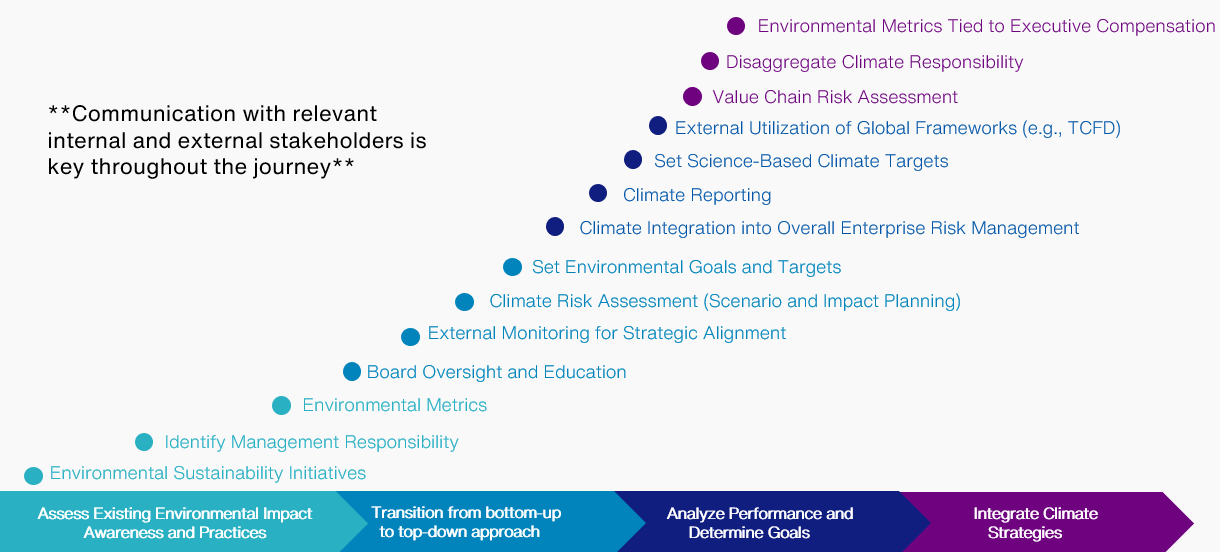Businesses can stay on top of new climate regulations and disclosures by approaching their strategy in three parts. First, take stock of current progress and map your journey forward. Second, ensure proper C-suite and board oversight. Third, integrate climate risks into enterprise risk management processes. We explain how to get started.
Environmental risks are prominent in ESG discussions and are increasingly more challenging for companies to understand, adapt to and effectively manage. That’s due to many factors, including the unpredictable impacts of climate change, new and proposed climate regulations, and investors’ evolving expectations on climate disclosures.
Looking across new and proposed regulations globally, it is safe to say that companies should begin to prepare to align to the Task Force on Financial-Related Climate Disclosures (TCFD) framework if they have not already. The 2021 TCFD status report highlighted that over 2,600 global organizations and 12 governments are endorsing TCFD disclosures.
Even though the nature of each company’s mandatory climate reporting is likely going to vary depending on the legislative or regulatory requirements of each jurisdiction, many of proposed reporting frameworks are expected to be aligned with the TCFD reporting requirements. For example, the European Commission has proposed comprehensive non-financial disclosures, which are likely to be influenced by existing ESG frameworks, including the TCFD. Similarly, the U.S. Securities and Exchange Commission’s recently proposed climate rule is largely modeled on the TCFD’s reporting framework. By aligning their reporting against the TCFD framework now, companies will be in the best position to report against these frameworks if – but, more likely, when – such reporting becomes mandatory.
“The decarbonization of the planet to achieve net zero implies the single biggest reallocation of capital the global economy has ever seen,” says Aon’s Head of Climate Strategy Richard Dudley. “At the same time, every firm needs to prepare for and mitigate risks associated with the impacts of climate change. Aon has built advisory and transactional capability in a range of areas to help clients navigate the significant uncertainty.”
Map Your Journey Using a Climate Maturity Curve
Aon’s new Climate Maturity Curve (see Figure 1) is an illustrative tool for companies to assess where they currently stand on their journey towards a robust climate strategy. Business leaders can use the curve to understand future steps they can take to advance the management of climate risks and opportunities. Aon’s comprehensive climate advisory solutions can support clients in each phase of their journey — whether that is building custom climate risk management processes, planning for climate-related disclosures or assessing your board’s effectiveness on climate oversight.
Regardless of where your company lies in maturity, it’s important to consider how you plan to progress your climate strategy in light of evolving regulatory and investor expectations. It’s important to note that companies don’t always map their journey on the curve in a perfect linear fashion. Sometimes organizations need to jump around on the curve or start higher and move lower. The point is to make progress and advance your strategy.
Figure 1 — Aon’s Climate Risk Maturity Model

Top-Down Climate Approach
Most companies already incorporate environmental initiatives in their operations to achieve cost savings and reduce their carbon footprint, such as reducing energy use and conserving water. Taking stock of what your company is already doing and beginning to develop metrics to measure progress year-over-year is a good starting point.
An important next step is to ensure proper leadership oversight over climate initiatives. (Click here for our infographic on establishing C-suite and board of director oversight of ESG.) Corporate boards should discuss how to formalize board and committee oversight over climate to enhance accountability. There is pressure on boards to appoint directors with relevant climate experience and have embedded climate responsibilities into existing board and committee charters to codify adequate oversight. Ongoing board education is also important here as well. Part of a successful top-down strategy is ensuring that climate risks and opportunities are well-understood by leaders in a fast-moving regulatory environment so they can incorporate that into the broader corporate strategy.
Once climate leadership is formalized at the board and senior management level, companies should undertake a peer benchmarking exercise to better understand their relative performance on climate issues, such as their level of qualitative and quantitative disclosure, use of frameworks and goals. Companies perceived as lagging behind peers on climate oversight will be more vulnerable to shareholder activism.
Integrating Climate Strategy Across the Organization
Along with new and proposed regulation across the globe, institutional investors increasingly expect companies to disclose climate-related impacts and risks consistent in public filings. In order to create a comprehensive disclosure aligned with TCFD, companies should consider conducting climate risk assessments, scenarios and financial impacts to then integrate identified climate risks into existing enterprise risk management processes.
Once a company has embedded climate risk into enterprise risk management and taken action to activate its climate strategy across business operations, the company should consider setting science-based targets and disclosing to TCFD or other reporting frameworks if they are not doing so already. As mentioned earlier, it is expected that TCFD will become a globally recognized climate reporting framework of choice.
Next Steps
As discussed, we recommend approaching your climate strategy into three areas: Assess your steps and progress on a climate maturity curve, create a process for leaders to be informed of climate risks and opportunities, and integrate the firm’s climate strategy with its enterprise risk management processes.
Identifying practical steps to progress will make you better suited to manage the ever-changing regulatory environment and meet investor and stakeholder demands.
Aon’s climate risk, global governance and ESG advisory services have the expertise to help your company move up the climate risk maturity curve and make timely, transformative and sustainable decisions. To speak with one of our experts about this topic, please write to [email protected].